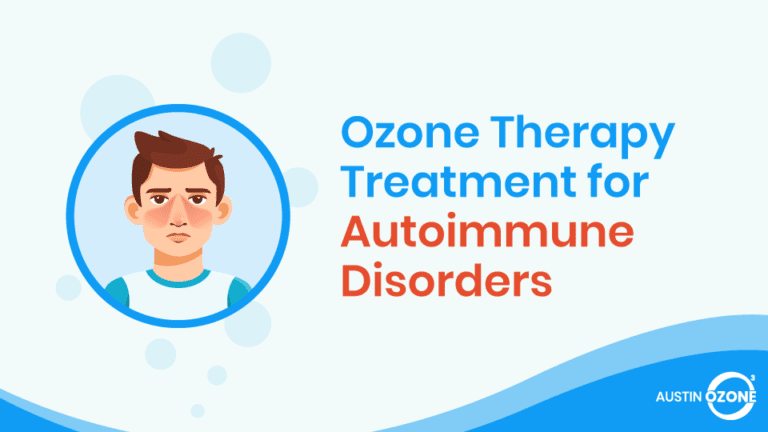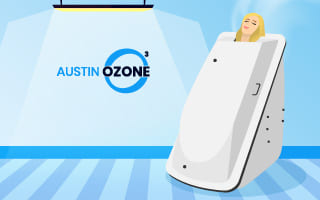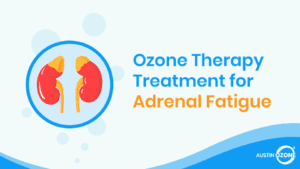Rheumatoid arthritis6 is an autoimmune disease that causes the immune system to attack healthy cells, resulting in the painful swelling or inflammation of the affected body areas, usually the joints.
Although rheumatoid arthritis often affects the joints in the knees, wrists, and hands, it can also damage other tissues in the body and cause serious problems in the heart, lungs, and eyes. Ozone therapy for rheumatoid arthritis is a new treatment method.
An Overview of Rheumatoid Arthritis
Rheumatoid arthritis is the most common type of autoimmune arthritis, although this disease often affects women more than men. The disease usually starts between the ages 30 and 50, although one can get rheumatoid arthritis at any age.
The stiffness of the joints is often worse upon first waking in the morning and may last for more than a couple of hours. However, the symptoms generally improve with the movement of the joints. This symptom is what sets rheumatoid arthritis apart from other types of arthritis (i.e., osteoarthritis9).
What Triggers Rheumatoid Arthritis?
Rheumatoid arthritis is an autoimmune disease, that is, your body’s own immune system starts attacking the healthy tissues in your joints, mistaking them for bacteria or viruses. The immune system generates inflammation that causes pain and swelling, in turn causing permanent damage in your tissue.
Similarly to other autoimmune diseases, no one really knows what exactly triggers rheumatoid arthritis. However, there is evidence3 suggesting that genetics can make some prone to developing rheumatoid arthritis at a particular stage in their lives. For example, people who are born with the human leukocyte antigen class II genotype are likely to acquire this disease.
Rheumatoid arthritis is an autoimmune disease, that is, your body’s own immune system starts attacking the healthy tissues in your joints, mistaking them for bacteria or viruses.
In addition, there are risk factors that can increase the chances of an individual developing rheumatoid arthritis. For example, studies show that the onset of rheumatoid arthritis begins as an individual enters their older years. Most of the people suffering from this disease are in their late 50s or above. Additionally, women are more prone to developing RA than men.
Lastly, the environment plays a vital role in developing rheumatoid arthritis. People who come from lower income households, with unhealthy or limited access to healthy food choices, are exposed to smoking, or who are obese have a higher risk of developing this disease.
What Are the Signs and Symptoms of Rheumatoid Arthritis?
Swelling and intense pain in the joints are the most common symptoms of rheumatoid arthritis6. However, it is also possible to experience stiffness and tenderness in the affected joints, as well as experience fever, weight loss or loss of appetite, weakness or loss of energy, and fatigue.
Some will even develop rheumatoid nodules, which are firm lumps found beneath the skin on the elbows and hands.
How to Diagnose Rheumatoid Arthritis?
Rheumatoid arthritis is diagnosed using a combination of physical examination, laboratory tests, x-rays, and ultrasound images. The diagnostician should be a rheumatologist or a physician who has expertise in dealing with this disease. This is because the signs and symptoms of rheumatoid arthritis are not that different from other types of inflammatory joint diseases.
Laboratory tests often include a blood test where analysts look for the presence of antibodies (anti-CCP and rheumatoid factor) and examine the levels of red blood cells and erythrocyte sedimentation rate.
Rheumatoid arthritis is diagnosed using a combination of physical examination, laboratory tests, x-rays, and ultrasound images.
Antibodies are substances that the immune system generates whenever it fights off a bacterial or viral infection. Since the immune system mistakes healthy tissues for a virus or bacteria during an episode of rheumatoid arthritis, specific antibodies are often seen in the blood tests.
Aside from blood tests, x-ray images can help in the early detection of rheumatoid arthritis, while the MRI and ultrasound images are used to determine the severity of the disease.
Early detection is important to reduce the possible damage in the tissues.
Common Treatment Methods for Rheumatoid Arthritis
As with other autoimmune diseases, there is no cure for rheumatoid arthritis. Patients can only get supportive care to manage its symptoms.
With proper medication, patients can experience immediate relief. However, there is no single treatment that can bring this relief. Majority of patients change their mode of treatment at least once to prevent the lasting effects of rheumatoid arthritis.
Patients are often given antirheumatic and anti-inflammatory drugs to relieve the symptoms and to reduce the progression of joint damage.
Patients are often given antirheumatic and anti-inflammatory drugs4 to relieve the symptoms and to reduce the progression of joint damage.
These drugs can be taken either orally or can be injected directly into the muscle. However, they often have side-effects. For more severe symptoms, patients are also asked to take biologic agents that can effectively block the signals that the immune system sends, which is the cause of the inflammation.
Schedule an Ozone Therapy Session Today!
What Happens When You Have Rheumatoid Arthritis?
Intense pain is not the only thing that you can experience when you are suffering from rheumatoid arthritis. It can potentially lower the quality of life.
Employers are less likely to hire individuals with rheumatoid arthritis since they will not be able to handle the physical demands of most jobs. It can also promote obesity, as the individual would be less likely to exercise due to the joint pain and stiffness.
Furthermore, people who have rheumatoid arthritis are likely to develop a permanent disability, or worse, it can lead to premature death.
Ozone Therapy for Rheumatoid Arthritis
Though there are many medical treatments that exist for the management of rheumatoid arthritis, most of these methods do not yield immediate relief and, at times, cause serious health complications along the way.
For this reason, it is in the best interest of patients to find new alternative ways to treat rheumatoid arthritis.
Ozone therapy can effectively reduce the pain, swelling, and stiffness that are commonly associated with rheumatoid arthritis.
Medical ozone has been extensively used since the early 1900s due to its therapeutic effects. Ozone is a gas composed of three oxygen atoms chemically bonded together.
Most ozone therapy treatments use an ozone-oxygen mixture3 (99.5: 0.5) generated by running pure oxygen through an ozone generator. Studies show that medical ozone has antimicrobial, anti-inflammatory, and immunomodulatory effects, which can help treat various diseases and ailments.
Ozone therapy5 can effectively reduce the pain, swelling, and stiffness that are commonly associated with rheumatoid arthritis.
How Ozone Therapy Works?
Upon administration, the medical ozone gas causes a mild oxidative stress through peroxidation, which activates the essential nuclear transcription factors (Nrf2). In turn, this process suppresses the secretion of pro-inflammatory cytokines.
The reduction of cytokine levels in the bloodstream eventually promotes immunomodulation, which is especially important in managing rheumatoid arthritis.
Medical ozone also helps increase the antioxidants in the blood stream of arthritic patients. These antioxidants play a vital role in preventing reactive oxygen species from generating hyaluronic acid, which is responsible for damaging the cartilages found in the joints.
The increase in antioxidants also helps inhibit chronic joint inflammation as demonstrated3 by those who underwent ozone therapy for rheumatoid arthritis.
The Efficacy of Ozone Therapy Against Rheumatoid Arthritis
Studies show that administering as little as 20 µg/mL of ozone significantly reduces the rheumatoid factor.
The frequency of administration also plays a huge factor in the efficacy of the treatment, as patients who are treated three times a week show a great improvement in the symptoms. Aside from reducing inflammation, ozone also helps patients get more acceptable blood test results.
Although there are many methods for administering ozone, it has been found that intra-articular injections7 are the most effective way for treating all types of arthritis, including rheumatoid arthritis. Best of all, there are no major adverse effects observed in patients who underwent this type of ozone therapy.
While existing studies show ozone therapy as a way of managing rheumatoid arthritis, additional studies are still needed to verify these results and the further effects of medical ozone on the human body.
Summary
Rheumatoid arthritis is an autoimmune disease that causes great pain to patients, leading to permanent disability and even death. Although nobody knows the exact cause of this disease, there are several risk factors that increase the chance of its development. Such factors include age, gender, genetics, socio-economic status, and the environment.
There is no singular way to diagnose rheumatoid arthritis. Since it shares its signs and symptoms with other types of arthritis, rheumatologists often advise patients to undergo several laboratory tests, MRI, x-rays, and ultrasound scanning to detect this disease.
Due to the fact that rheumatoid arthritis is essentially an abnormality in the immune system, no cure can reverse its effects. The only thing patients can do is manage its symptoms to enable them to do their normal daily activities.
Although there are medications available that can help patients manage the pain and swelling, most of them have serious side-effects that can deteriorate human health.
For this reason, some experts recommend ozone therapy as a safe and effective alternative to antirheumatic drugs. Many ongoing ozone therapy studies show its positive results in alleviating the symptoms of rheumatoid arthritis, as well as other types of arthritis, but further clinical studies are still needed to solidify these claims and results.
Schedule an Appointment Today
References
- Anzolin, A., & Bertol, C. (2018). Ozone therapy as an integrating therapeutic in osteoartrosis treatment: a systematic review. Brazilian Journal of Pain, 1(2), 171-175. http://dx.doi.org/10.5935/2595-0118.20180033
- Baranova, I. (2018). The use of the functional state of the joints for the estimation of the effectiveness of the application of oxygen/ozone therapy for the rehabilitative treatment of the patients suffering from knee arthritis. Vopr Kurortol Fizioter Lech Fiz Kult, 95(3), 42-48. doi: 10.17116/kurort201895342.
- Bozbas, G., & Sendur, O. (2016). New Therapeutıc Approach in Rheumatoıd Arthrıtıs: Ozone. International Journal of Physiatry, 2(1). doi.org/10.23937/2572-4215.1510007
- Orliman. (n.d.). Ozone therapy revolutionises the treatment of arthritis. Retrieved from https://www.orliman.com/en/ozone-therapy-revolutionises-the-treatment-of-arthritis/
- Pain & Arthritis Relief Center. (n.d.). OZONE THERAPY ROCKVILLE MD. Retrieved from https://painarthritisrelief.com/ozone-therapy-rockville-md/
- Pyper, L. (2016, January 4). Rheumatoid arthritis: How ozone can help. Retrieved from https://salvagente.co.za/ozone-saunas/rheumatoid-arthritis-how-ozone-can-help/
- Raeissadat, S., Rayegani, S., Forogh, B., Abadi, P., Moridnia, M., & Dehgolan, S. (2018). Intra-articular ozone or hyaluronic acid injection: Which one is superior in patients with knee osteoarthritis? A 6-month randomized clinical trial. Journal of Pain Research, 11, 111-117. doi: 10.2147/JPR.S142755.
- Rapposelli, D. (2017, August 25). Ozone safe, effective for knee osteoarthritis pain. Retrieved from https://www.clinicalpainadvisor.com/home/topics/musculoskeletal-pain/arthritis/ozone-safe-effective-for-knee-osteoarthritis-pain/
- Robins, H. (n.d.). Arthritis. Retrieved from https://www.ozonedoctor.net/services/arthritis






